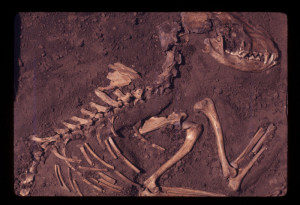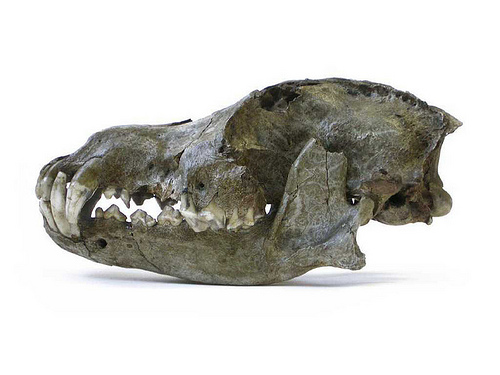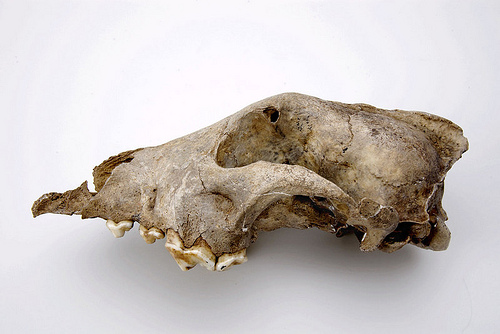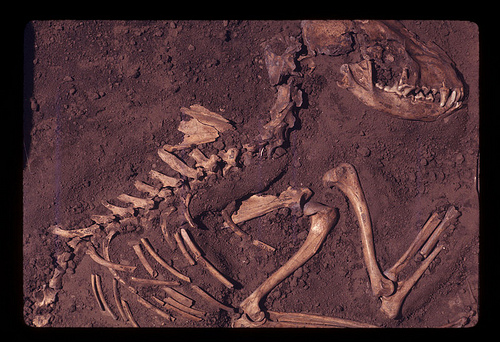
Scientists have theorized that the origin of the domestic dog stems from the domestication of the Grey Wolf tens of thousands of years ago. But the approximate date and place have been grist for scientific debate for years, with some genetic and archaeological evidence indicating that humans domesticated wolves on more than one occasion, with today’s lineage arising at the latest 15,000 years ago based on findings at the Bonn-Oberkassel site in Germany, and genetic evidence pointing to 33,000 years ago from investigations of the Razboinichya Cave in the Altai Mountains of Russia.
Now, based on a recently completed study, Olaf Thalmann of the University of Turku, Finland, and colleagues are suggesting that Palaeolithic hunter-gatherers in Europe as much as 32,000 years ago may have played a significant role in the process.
To come to this conclusion, Thalmann and his team compared mitochondrial DNA from a broad range of modern-day dog and wolf breeds to mitochondrial DNA from canine fossils dated to 19,000-32,000 years ago, as well as fossils from modern canines. Their analysis showed that modern dogs’ genetic sequences most closely matched those of either ancient European canines, including wolves, or modern European dogs, but did not closely match DNA from canines outside of Europe. According to the researchers, this suggests a European origin, and, as only hunter-gatherer populations were present during this period, a domestication that predates the advent of agriculture.
_______________________________________________________________________________________________________________________
Above: A lateral view of a Pleistocene wolf from the Trou des Nutons cave (Belgium), calibrated age of 26,000 years Before the Present. This wolf species was particularly large. [Image courtesy of Royal Belgian Institute of Natural Sciences]
________________________________________________________________________________________________________________________
A lateral view of a Palaeolithic dog from the Goyet cave (Belgium), calibrated age of 36,000 years Before the Present. Thalmann et al. believe the species represented by this fossil to be an ancient sister-group to all modern dogs and wolves, rather than a direct ancestor. [Image courtesy of Royal Belgian Institute of Natural Sciences]
_______________________________________________________________________________________________________________________
Dog burial from Horizon 11 of the Koster site, Greene County, Illinois, US. The fossil specimen at this site have a calibrated age of 8,500 years Before the Present. [Image courtesy of Del Baston, Center for American Archaeology]
_______________________________________________________________________________________________________________________
It has been previously thought that fields and crops attracted wolves to villages, leading to interactions with humans that eventually resulted in a cooperative or symbiotic relationship. Human intervention in canine evolution thus produced the variety of modern dog breeds commonly seen today in homes and dog parks throughout the world. But this study, along with clues from other research and excavations, pushes the origins back further to the Palaeolithic Age, when wild wolves may have been drawn to hunter-gatherers, the researchers suggest, because they could feed on carcasses the hunters left behind.
The details of the research appears in the 15 November 2013 issue of Science, published by AAAS, the nonprofit science society.
________________________________________________________________________________________________________________________
Read about the most fascinating discoveries with a premium subscription to Popular Archaeology Magazine. Find out what Popular Archaeology Magazine is all about. AND MORE:
 Popular Archaeology’s annual Discovery edition is a selection of the best stories published in Popular Archaeology Magazine in past issues, with an emphasis on some of the most significant, groundbreaking, or fascinating discoveries in the fields of archaeology and paleoanthropology and related fields. At least some of the articles have been updated or revised specifically for the Discovery edition. We can confidently say that there is no other single issue of an archaeology-related magazine, paper print or online, that contains as much major feature article content as this one. The latest issue, volume 2, has just been released. Go to the Discovery edition page for more information.
Popular Archaeology’s annual Discovery edition is a selection of the best stories published in Popular Archaeology Magazine in past issues, with an emphasis on some of the most significant, groundbreaking, or fascinating discoveries in the fields of archaeology and paleoanthropology and related fields. At least some of the articles have been updated or revised specifically for the Discovery edition. We can confidently say that there is no other single issue of an archaeology-related magazine, paper print or online, that contains as much major feature article content as this one. The latest issue, volume 2, has just been released. Go to the Discovery edition page for more information.
Subscription Price: A very affordable $5.75 for those who are not already premium subscribers of Popular Archaeology Magazine (It is FREE for premium subscribers to Popular Archaeology). Premium subscribers should email [email protected] and request the special coupon code. Or, for the e-Book version, it can be purchased for only $3.99 at Amazon.com.








